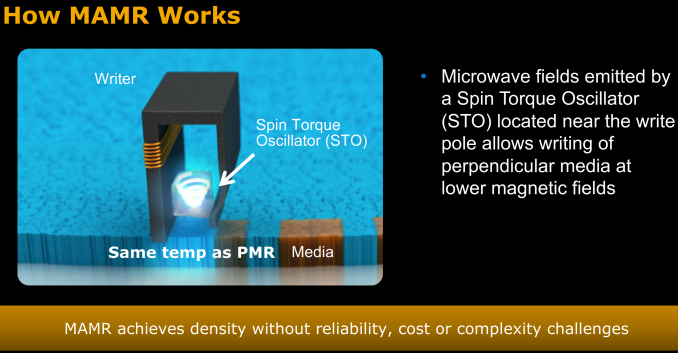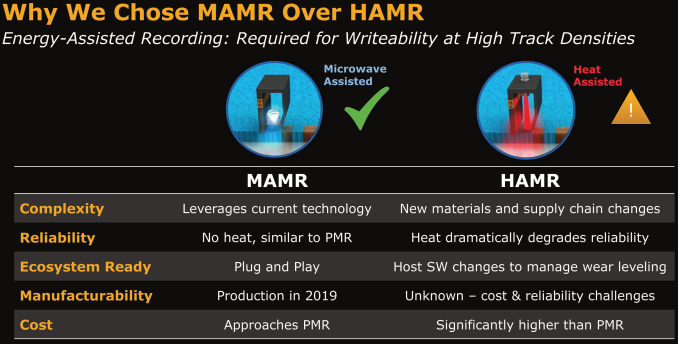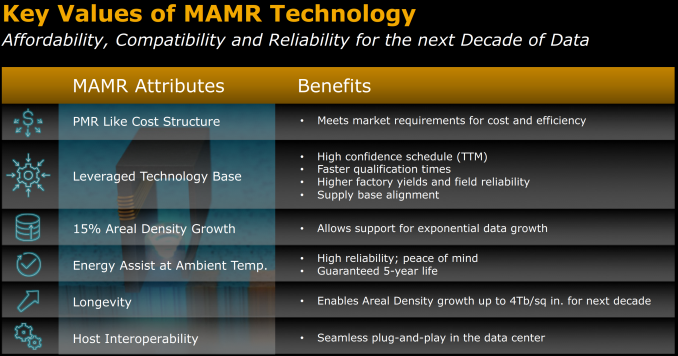Western Digital Stuns Storage Industry with MAMR Breakthrough for Next-Gen HDDs
by Ganesh T S on October 12, 2017 8:00 AM ESTMicrowave Assisted Magnetic Recording (MAMR)
The WD Breakthrough
Western Digital's Microwave Assisted Magnetic Recording (MAMR) drives use platters very similar to those in the current-generation PMR drives*. This means that the innovation to enable MAMR is mainly to do with the heads that perform read and write operations.
As part of the MAMR design, WD pointed out to its shift to the damascene process for building the bit grains as the key enabler for the MAMR breakthrough. The process allows them to fabricate a spin torque oscillator (STO) capable of creating precise energy fields without any additional overheads. The embedded oscillator in the head is tuned to generate microwaves with a frequency of 20-40 GHz, and this provides the 'energy-assist' to make it easier to write to the bits (technically it lowers the coercivity of the underlying recording media).
* Current drives use an aluminium substrate with a cobalt-platinum layer.
WD pointed out that MAMR requires absolutely no external heating of the media that could lead to reliability issues. The temperature profiles of MAMR HDDs (both platters and drive temperature itself) are expected to be similar to those of the current generation HDDs. It was indicated that the MAMR drives would meet all current data center reliability requirements.
Based on the description of the operation of MAMR, it is a no-brainer that HAMR has no future in its current form. Almost all hard drive industry players have a lot more patents on HAMR compared to MAMR. It remains to be seen if the intellectual property created on the HAMR side is put to use elsewhere.
Western Digital has talked about timeframes for the introduction of MAMR drives. They had working prototypes on display at the press and analyst event yesterday. WD's datacenter customers have their own four to six month qualification cycle, and MAMR drives for that purpose are expected to be out towards the middle of next year. Production-level HDDs based on MAMR technology are expected to start shipping in 2019.
Western Digital sees plenty of value in MAMR, and it is not hard to see why. MAMR technology allows for the bit densities of individual platters to scale to more than 4 Tb/sq.in. WD believes that it is well-positioned to bring 40TB drives by 2025 using MAMR alone.
Technologies such as SMR and TDMR are complementary to MAMR. Currently, WD does not use TDMR in any shipping enterprise drive, and SMR is restricted to a few host-managed models. It is possible that some MAMR drives will use those technologies to achieve higher capacity points compared to conventional drives. WD's working prototype on display was a helium drive (HelioSeal), but, WD again stressed that helium is not a compulsory requirement for MAMR drives. It was also confirmed that drives of 16TB and more would have to be MAMR-based.
In 2005, when the shift from longitudinal recording to PMR happened, most vendors managed to release drives based on the new technology within a few years of each other. The shift to helium in 2012, though expected by everyone in the industry, proved to be a big win for HGST - they had the markets that focus on high-capacity, or low-power, or low TCO to themselves for almost three years before Seagate eventually caught up. Toshiba is yet to release a helium drive publicly. It is going to be interesting to see how Seagate and Toshiba respond to this unexpected MAMR announcement from Western Digital.
The players in the hard drive industry have a robust cross-licensing program, and it is highly likely that other manufacturers will not face significant patent bottlenecks in bringing out MAMR drives on their own. WD stressed that the development is a multi-year effort, particularly if the heads are still being manufactured in the old dry pole process.
High-volume mature hard drives are often manufactured with the help of third-party suppliers - such as Showa Denko for the recording media and TDK for the heads. In the case of the MAMR drives, WD mentioned that all the components are being designed and manufactured in-house. It is possible for the competition to catch up faster if some of the third-party manufacturers are further along in their own R&D. In particular, TDK has been investing in MAMR R&D recently too. Toshiba has also shown interest in the same, but it is not clear how far along they are in the commercial development cycle. Currently, we believe WD has a clear lead in MAMR technology. It just remains to be seen how long it takes for the competition to catch up.














127 Comments
View All Comments
AnTech - Friday, October 13, 2017 - link
Bring faster, larger and cheaper SSD. Once you try them, you do not want rotational mechanical disks, even for free!Lolimaster - Saturday, October 14, 2017 - link
For movies, music, pictures (except for thumbnail generation), game storage HDD is the thing you want.SSD is basically OS/Apps and some open world games, and store things for a casual user (<500GB at any given time and max usage for years).
someonesomewherelse - Saturday, October 14, 2017 - link
So where are the cheap (~100 eur) 12 GB drives? #teamdatahoardingPeskarik - Sunday, October 15, 2017 - link
This is a really interesting article to read for a layman, thank you!zodiacfml - Sunday, October 15, 2017 - link
Not sure about them posting negativity of HAMR. I think it is about cost and not reliability. The heat from HAMR can be reduced significantly with a shorter and narrow laser pulse.Overmind - Wednesday, October 25, 2017 - link
@Samus - No. Heat canont beat uW and has too many drawbacks that decraese reliability.@cekim - You are thinking in obsolete RAID only with nothing else terms. Current solutions are much more complex and faster ever if they are based on RAIDs. You failed to consider the speed increase of the drives.
@Jaybus - 1 gigabit Ethernet is obsolete when it comes to storage systems. Storage systems use high speed optical connections of dozens of gigabit/s. SANs do have a purpose, you know...
@tuxRoller - cloud is not something to use as backup if you have a lot of data.
@alpha754293 - Yes, cekim did not consider the speed increase.
@Arbie - True. And price must stay low so HDDs can keep the largest part of the market.
@sonny73n - Someone decided that the computer KB that = 1024 violates the S.I. definition of a kilo, which is 1000. So they invented the KiB, MiB and so forth absurdities. Veterans don't use that junk naming though. For us, the KB is still 1024 and the TB is still 1099511627776. So no worries.
FvBilsen - Thursday, November 9, 2017 - link
Can somebody make the WD presentation with the slides in this article available ? Can somebody give me guidance how to get this ?